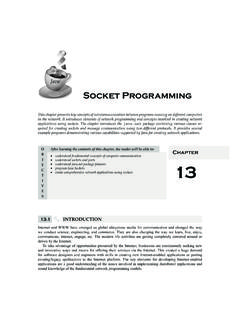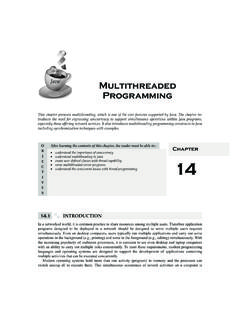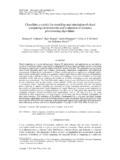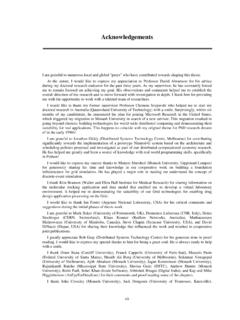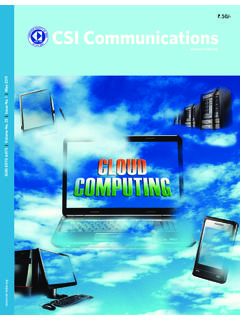Transcription of Fog Computing: Helping the Internet of Things …
1 40 COMPUTER PUBLISHED BY THE IEEE COMPUTER SOCIETY 0018-9162/16/$ 2016 IEEECLOUD COVERThe Internet of Things (IoT) promises to make many items including consumer electronic devices, home appliances, medical devices, cam-eras, and all types of sensors part of the Inter-net This opens the door to innovations that facilitate new interactions among Things and humans, and enables the realization of smart cities, infrastruc-tures, and services that enhance the quality of 2025, researchers estimate that the IoT could have an economic impact including.
2 For example, revenue generated and operational sav-ings of $11 trillion per year, which would represent about 11 percent of the world economy;2 and that users will deploy 1 trillion IoT WITH Internet OF TH INGS DATAIoT environments generate un-precedented amounts of data that can be useful in many ways, par-ticularly if analyzed for insights. However, the data volume can over-whelm today s storage systems and analytics computing could help by offering on-demand and scal-able storage, as well as processing services that can scale to IoT requirements.
3 However, for health- monitoring, emergency-response, and other latency- sensitive applications, the delay caused by trans-ferring data to the cloud and back to the application is unacceptable. In addition, it isn t efficient to send so much data to the cloud for storage and processing, as it would saturate network bandwidth and not be analysis of a healthcare-related IoT application with 30 million users showed data flows up to 25,000 tuples per And real-time data flows in smart cities with Fog computing .
4 Helping the Internet of Things Realize its PotentialAmir Vahid Dastjerdi and Rajkumar Buyya, University of MelbourneThe Internet of Things (IoT) could enable innovations that enhance the quality of life, but it generates unprecedented amounts of data that are difficult for traditional systems, the cloud, and even edge computing to handle. Fog computing is designed to overcome these limitations.
5 AUGUST 2016 41 EDITOR SAN MURUGESAN BRITE Professional more data sources could easily reach millions of tuples per second. To address these issues, edge com-puting4 was proposed to use comput-ing resources near IoT sensors for local storage and preliminary data process-ing. This would decrease network con-gestion, as well as accelerate analysis and the resulting decision making.
6 However, edge devices can t handle multiple IoT applications competing for their limited resources, which re-sults in resource contention and in-creases processing computing which seamlessly integrates edge devices and cloud re-sources helps overcome these lim-itations. It avoids resource conten-tion at the edge by leveraging cloud resources and coordinating the use of geographically distributed edge computing CHARACTERISTICSFog computing is a distributed para-digm that provides cloud-like services to the network edge.
7 It leverages cloud and edge resources along with its own infrastructure, as Figure 1 shows. In essence, the technology deals with IoT data locally by utilizing clients or edge devices near users to carry out a substantial amount of storage, com-munication, control, configuration, and management. The approach bene-fits from edge devices close proximity to sensors, while leveraging the on- demand scalability of cloud computing involves the compo-nents of data-processing or analytics applications running in distributed cloud and edge devices.
8 It also facili-tates the management and program-ming of computing , networking, and storage services between datacen-ters and end devices. In addition, it supports user mobility, resource and interface heterogeneity, and distrib-uted data analytics to address the requirements of widely distributed ap-plications that need low COMPONENTSF igure 2 presents a fog- computing reference architecture. Fog systems generally use the sense-process-actu-ate and stream-processing program-ming models.
9 Sensors stream data to IoT networks, applications running on fog devices subscribe to and process the information, and the obtained in-sights are translated into actions sent to systems dynamically dis-cover and use APIs to build com-plex functionalities. Components at the resource-management layer use information from the resource- monitoring service to track the state of available cloud, fog, and network resources and identify the best can-didates to process incoming tasks.
10 With multitenant applications, the resource-management components prioritize the tasks of the various par-ticipating users or and cloud resources commu-nicate using machine-to-machine (M2M) standards such as MQTT (for-merly MQ Telemetry Transport) and the Constrained Application Protocol (CoAP). Software-defined networking (SDN) helps with the efficient manage-ment of heterogeneous fog SOFTWARE SYSTEMST here are four prominent software systems for building fog computing environments and AProvider BPublic cloudPrivate cloudPrivate cloudIoT computingFigure 1.
